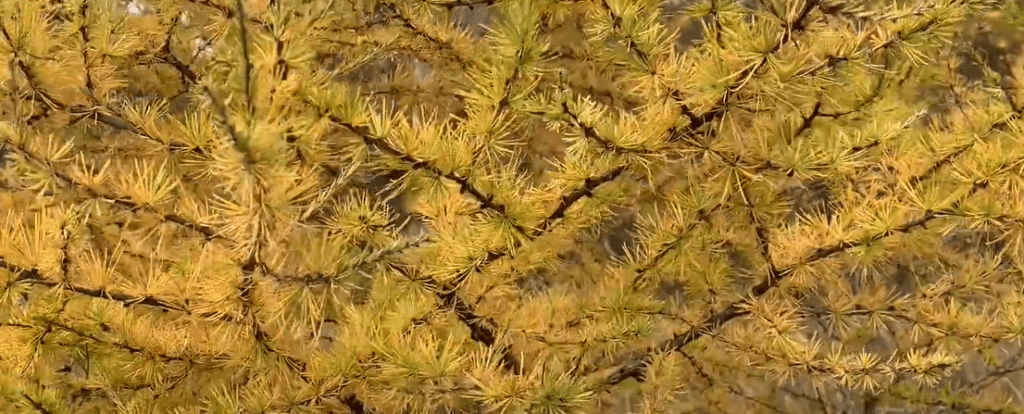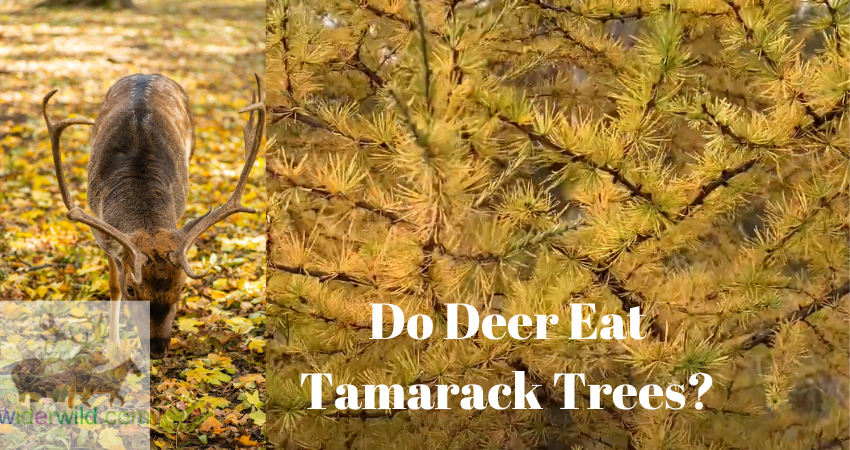Deer do not typically eat tamarack trees as they prefer other types of plants for forage. Tamarack trees, also known as larch trees, are typically not a preferred food source for deer.
While deer are known to browse a variety of plant species, they tend to prefer woody shrubs and succulent vegetation.
Tamarack trees are conifers that lose their needles in the fall, making them less attractive to deer. These trees are more commonly found in wetland areas and are known for their resilience in harsh environments.
Despite their hardiness, deer are unlikely to significantly impact tamarack tree populations. This is good news for those who appreciate the beauty and ecological importance of these unique trees.
Plantskydd Deer Repellent, you provide a practical and eco-friendly solution for visitors concerned about protecting their tamarack trees from deer browsing.
Gear up for the hunt with this Camo US Flag Deer Elk Buck T-Shirt—perfect for proud hunters and outdoorsmen. Grab yours today and show off your passion in style!
The Habitats Of Tamarack Trees
Tamarack trees, also known as Eastern Larch, are native to North America and can be found in various habitats across the continent. These deciduous conifers thrive in wetland environments, making them particularly well-suited to moist forests, bogs, and swamps.
Understanding the habitats in which tamarack trees flourish is crucial to appreciating their role in ecosystems and the interaction between these remarkable trees and their surroundings.
Overview Of Tamarack Tree Habitats
Tamarack trees are highly adaptable and can tolerate a wide range of conditions, enabling them to thrive in diverse habitats. However, they are especially prevalent in wetland settings with standing water and high soil moisture content.
These trees often grow alongside other water-loving species, including black spruce, tamarack birch, and cedar, creating rich and diverse ecosystems.
In the northern regions of North America, tamarack trees commonly inhabit the boreal forest, where they play a crucial role in the landscape. These trees flourish in taiga ecosystems characterized by cold winters, short growing seasons, and wetland areas.
Tamaracks are equipped with unique adaptations that allow them to withstand these challenging conditions, such as flexible branches that can sway and bend under the weight of heavy snow.
Importance Of Tamarack Trees In Ecosystems
Tamarack trees are not only visually striking but also vital to the health and balance of their ecosystems.
Their presence contributes to the overall biodiversity of wetland habitats, supporting a wide array of wildlife species, including birds, mammals, and amphibians.
The dense branches and foliage provide shelter and nesting sites for various birds, while tamarack forests attract insects that serve as a food source for many animals.
Furthermore, tamarack trees have a significant impact on water quality in wetlands. Their roots help stabilize the soil and prevent erosion, ensuring the integrity of fragile aquatic ecosystems.
The fallen leaves and needles of tamaracks also contribute organic matter to the soil, enriching it and providing nutrients for other plant species.
Moreover, the shade provided by these trees helps regulate water temperature, maintaining a favorable habitat for aquatic organisms.
In addition to their role in ecosystems, tamarack trees have cultural and economic importance. Indigenous communities have traditionally used various parts of the tree, such as the bark and wood, for practical purposes including construction, medicine, and crafts.
The timber industry also values tamarack wood for its strength and durability, using it in the production of utility poles, railroad ties, and fence posts.
The habitats of tamarack trees are critical ecosystems that support a wide range of flora and fauna.
Understanding the unique adaptations and contributions of these trees allows us to appreciate their significance and work toward the conservation of their wetland habitats.
Tamarack Tree Characteristics

Tamarack trees, known for their needle-like leaves that change color in the fall, are generally not favored by deer as a food source.
However, in extreme cases of winter food scarcity, deer may consume some parts of the tree, particularly the young shoots and twigs.
Description Of Tamarack Tree Appearance
Tamarack trees, scientifically known as Larix laricina, are native to North America and are often found in wetlands and bogs.
These coniferous trees showcase several unique characteristics that make them easily identifiable. When it comes to their appearance, tamarack trees have the following distinguishing features:
- Their height ranges from 25 to 80 feet, with some exceptional species reaching up to 100 feet.
- Their thin, scaly bark is reddish-brown in color, providing a beautiful contrast against the vibrant green foliage.
- Soft, slender branches extend outwards from the trunk, giving the tree an elegant and delicate look.
- The needles of tamarack trees are unique, as they turn bright yellow in the autumn and fall off during the winter months.
Unique Features Of Tamarack Trees
While tamarack trees share some common traits with other conifers, they possess distinct features that set them apart. These unique characteristics of tamarack trees contribute to their ecological importance and overall charm:
- Tamarack trees are deciduous conifers – unlike most conifers, they shed their needles annually, providing a spectacular display of vibrant yellow foliage in the fall.
- What makes tamarack trees especially remarkable is their remarkable ability to tolerate saturated soil. They thrive in wetland areas where other trees struggle to survive.
- These trees have been utilized traditionally by indigenous communities, who appreciate their water-resistant wood. The wood is often used for constructing canoes and shingles due to its exceptional durability.
Growth Patterns And Lifespan Of Tamarack Trees
Tamarack trees exhibit unique growth patterns and have a lifespan influenced by various factors. Understanding their growth habits is essential for cultivating and preserving these fascinating trees:
- Typically, tamarack trees have a relatively fast growth rate and can grow more than two feet per year under optimal conditions.
- They commonly grow in clumps or stands rather than as solitary trees, creating an enchanting and picturesque landscape when found in groups.
- The lifespan of tamarack trees can range from 50 to 150 years, depending on the environmental conditions they experience during their growth.
The Diet Of Deer
Understanding the feeding habits of deer is crucial for anyone who wants to protect their vegetation, especially when it comes to certain tree species like the Tamarack.
By gaining a better understanding of what deer eat and why, you can effectively implement strategies to protect your Tamarack trees.
Overview Of Deer’s Feeding Habits
Deer are opportunistic herbivores, meaning that their diet primarily consists of plant matter. They are known for their adaptability and can adjust their feeding habits based on the availability of food sources in their natural habitat.
Generally, deer have a selective feeding behavior, preferring certain types of plants over others.
Primary Food Sources For Deer
Deer have a wide range of primary food sources that sustain their diet throughout the year.
These food sources include:
Grasses: Deer often feed on various types of grasses, which provide them with important nutrients, especially during the spring and summer months when these plants are abundant.
Forbs: Forbs are broad-leaved flowering plants such as clover, dandelions, and wildflowers. These plants are rich in protein and are a significant part of a deer’s diet.
Shrubs and Small Trees: Deer also feed on the tender shoots, leaves, and buds of shrubs and small trees. This includes species such as maple, blackberry, and raspberry.
Acorns and Nuts: During the fall, acorns and nuts become a crucial food source for deer. They are high in carbohydrates and fat, providing the necessary energy for the animals to survive the colder months.
Crops: Deer are notorious for their fondness of crops such as soybeans, corn, and alfalfa. These agricultural plants offer a highly palatable food source, making them vulnerable to deer damage.
Factors Influencing Deer’s Food Choices
Several factors influence a deer’s food choices, making them more inclined to consume certain plants over others.
These factors are:
Seasonality: As the seasons change, so do the food options available to deer. Understanding the seasonal variations in plant growth and availability helps predict their feeding habits.
Taste and Palatability: Deer have different preferences when it comes to taste and palatability. They tend to select plants that are more nutritious, easy to digest and have flavors they find appealing.
Availability and Accessibility: The availability and accessibility of food sources greatly influence deer’s feeding patterns. They are more likely to target plants that are within their reach and abundant in their habitat.
Competition: If resources are limited, competition among deer can affect their food choices. They may opt for alternative food sources if their preferred plants are heavily browsed by other deer.
Social Learning: Deer can learn from other deer within their social groups about suitable food sources. They may imitate the feeding behaviors of more experienced individuals.
Understanding these factors will provide valuable insights into the selective feeding habits of deer and the potential impact on Tamarack trees.
By taking proactive measures to protect your vegetation and managing deer populations responsibly, you can ensure the continued health and growth of your Tamarack trees.
Deer-tamarack Tree Interaction
Understanding the relationship between deer and tamarack trees is crucial for those interested in both wildlife management and the conservation of these unique conifers.
The tamarack tree, also known as the American larch, holds a special place in ecosystems due to its ability to thrive in moist environments and contribute to biodiversity.
However, the presence of deer can have an impact on the growth and health of tamarack trees, raising questions about whether or not deer eat these particular trees.
Understanding The Relationship Between Deer And Tamarack Trees
Tamarack trees (Larix laricina) are native to North America and can be found in various regions across the continent.
These deciduous conifers offer numerous ecological benefits, including acting as a habitat for many bird species, providing shelter for small mammals, and contributing to the overall diversity of wetland ecosystems.
Do Deer Eat Tamarack Trees?
While tamarack trees are not typically the top choice in a deer’s menu, deer have been known to browse on them, especially during certain seasons and in specific circumstances. Deer are primarily herbivores, and their diet mainly consists of leaves, shoots, twigs, and other vegetation.
While they primarily target more palatable food sources, such as grasses, shrubs, and agricultural crops, they may occasionally consume tamarack tree foliage, especially if other food options are limited.
Deer feeding preferences can vary depending on factors such as geographic location, time of the year, availability of alternative food sources, and population density.
While tamarack trees may not be the top choice in a deer’s menu, they may still be susceptible to browsing, particularly in areas with high deer populations.
Observations And Studies On Deer-tamarack Tree Interactions
Researchers have conducted studies and observations better to understand the dynamics between deer and tamarack trees.
These studies have focused on monitoring deer browsing patterns and assessing the impacts on the growth and regeneration of tamarack trees.
Some notable findings from these studies include:
- The intensity of deer browsing on tamarack trees can vary based on factors like deer population density and proximity to alternative food sources.
- Deer browsing can affect the growth rate, survival, and structure of tamarack tree populations, particularly in areas with high deer densities.
- Deer browsing can impact the composition and diversity of understory vegetation near tamarack trees.
These observations and studies emphasize the need for effective deer management strategies to ensure the long-term health and sustainability of tamarack tree populations and their associated ecosystems.
The relationship between deer and tamarack trees is complex and influenced by various factors. While deer may not commonly consume tamarack tree foliage, understanding their potential impact is essential for maintaining the delicate balance of ecosystems where these unique conifers thrive.
Impacts Of Deer Consumption On Tamarack Trees
Deer browsing, or the consumption of vegetation by deer, can have significant impacts on tamarack trees. Tamarack trees are often prime targets for deer browsing, as their tender shoots and twigs are a preferred food source for these herbivores.
The effects of deer consumption on tamarack trees can range from stunted growth to reduced tree health and even mortality.
In this section, I will explore the effects of deer browsing on tamarack tree health and growth, strategies to protect tamarack trees from deer browsing, and the importance of balancing the conservation efforts for deer and tamarack trees.
Effects Of Deer Browsing On Tamarack Tree Health And Growth
Deer browsing on tamarack trees can significantly impact their health and growth. When deer consume the tender shoots and twigs of tamarack trees, it hampers their ability to photosynthesize and produce energy.
This can lead to stunted growth and reduced overall tree health. Additionally, excessive browsing can weaken the defense mechanisms of tamarack trees, making them more susceptible to diseases and insect infestations.
The constant stress caused by deer browsing can eventually lead to the death of tamarack trees, resulting in a loss of biodiversity and ecological balance.
Strategies To Protect Tamarack Trees From Deer Browsing
Protecting tamarack trees from deer browsing is crucial to ensure their survival and growth. Fortunately, there are several effective strategies that can be implemented to minimize deer damage to tamarack trees:
Physical barriers: Installing fencing or tree shelters around tamarack trees can physically prevent deer from accessing them. These barriers should be tall enough to deter deer from jumping over or reaching the tree canopy.
Repellents: Various chemical or natural deer repellents can be used to discourage deer browsing. Spraying these repellents on the foliage of tamarack trees can make them less appealing to deer.
Planting deer-resistant plants: Introducing other plants in the vicinity of tamarack trees that are less appealing to deer can divert their attention away from the tamarack trees.
Balancing The Conservation Of Deer And Tamarack Trees
While protecting tamarack trees from deer browsing is essential, it is crucial to strike a balance between the conservation efforts for both deer and tamarack trees.
Deer play an important role in the ecosystem as seed dispersers and their population management is essential for maintaining a healthy balance.
Conservation organizations and land managers need to consider implementing sustainable deer population control measures to prevent overbrowsing while simultaneously protecting tamarack trees and other vegetation.
By understanding the impacts of deer consumption on tamarack trees, implementing effective protection strategies, and maintaining a balance in conservation efforts, we can strive towards the preservation of both deer and tamarack tree populations, ensuring a thriving ecosystem for future generations.
Frequently Asked Questions For Do Deer Eat Tamarack Trees?
Do Tamarack Trees Attract Deer?
Tamarack trees undeniably attract deer with their sweet foliage and buds, positioning them as a favored food source for these graceful creatures.
Are Tamarack Trees Poisonous To Deer?
Not at all. Tamarack trees are not poisonous to deer; instead, they stand as a valuable and safe food source that contributes to the overall well-being of these animals.
How Do Tamarack Trees Benefit Deer?
Tamarack trees play a crucial role in benefiting deer by providing a nutritious food source, especially during the harsh winter months when alternative vegetation is scarce.
Do Deer Damage Tamarack Trees?
Unfortunately, yes. Deer can cause damage to tamarack trees by browsing on their foliage and rubbing their antlers against the trunks, posing a challenge to the health of these trees.
Can Tamarack Trees Survive Deer Browsing?
While tamarack trees have the potential to survive deer browsing, repeated instances of such activity can hinder their growth and overall vitality.
Are Tamarack Trees a Preferred Food for Deer?
Indeed, tamarack trees are highly regarded as a preferred food source for deer, owing to the delectable taste of their foliage and buds.
What Are Some Ways To Protect Tamarack Trees From Deer?
Safeguarding tamarack trees from deer involves strategic measures such as fencing, the application of repellents, or considering alternative plantings that are less appealing to deer, ensuring the preservation of these valuable trees in your landscape.
Final Words
Tamarack trees may be an appealing food source for deer, with their soft needles and nutritious buds. However, it is important to note that deer generally do not prefer tamarack trees as a primary food source.
While they may occasionally browse on tamaracks for variety or during times of scarcity, their impact on the overall health of the trees is typically minimal.
So, if you’re worried about tamarack trees being devoured by deer, rest assured that they are usually not a top choice on the menu for these graceful creatures.
Read Related Post on Deer Diet and Feeding Habits:


